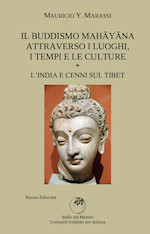When Śākyamuni withdraws into the forest, he enters a space that had been inhabited for centuries by ascetics, the śrāmaņa, “those who strive” searching for the absolute through their bodies. And this is not enough.
When he who would become Buddha, the Awakened, he who penetrated and revealed to himself the gateway to the new gospel — which consists in allowing the world to fade away instead of trying to abolish it – when Buddha began his apprenticeship of the Upanishad and of the Sāmkhya with the forest teachers, that world had expanded to include many new elements, the most important of which I will speak of presently.
After the gradual expansion of the neolithic settled communities, the most ancient civilization, complete with a religion, a writing system and complex government structures so far discovered by archaeologists, had two separate centres, in Mesopotamia and in Egypt. The protracted interaction between these two highly refined cultural hubs in the end brought to the development of the languages, the writing systems, the myths and the religions that constitute the embryo of a large part of our own intellectual and symbolic world today (7).
This bipolarism lasted about two millennia in a relative balance, until the migration towards Egypt and Europe of Semitic and Accadic peoples gave origin respectively to Hebraism and the Greek and Latin civilizations, which in turn, constituted the hotbed from which Christianity and Islam rose in more recent times. Here, from the very beginning, Religion meant above all gnosis and ethics. At the time of king Sargon the Great, in 2350 b.C. the Accadian’s empire extended from the Mediterranean in the West almost to the edge of the Gandhara region in the East (8). Then, in a later period, the Veda and the Upanishad sprouted from the knowledge rooted in the Avesta (9).
The complex of religious ideas that flows from the Avesta and emerges refined and structured in the Veda, shared the insight of a relationship between man and the absolute which the Upanishads express in the very forceful statement “so ham” “I am That”. The awareness that there is a gesture, a bearing of the body that moulds it after the absolute was matched by the conscience that human nature in its essence is in God.
III) The trace of words
The most ancient (written!) vestige of a moral statement in the deepest religious sense is to be found among the aphorisms of the Egyptian Amen-en Apt, who lived during the eight dynasty (1500-1360 b. C.): «It is better to be a beggar in God’s palms than a rich man under the shelter of a roof” (10). The moral ethics shared by all Indian religious forms before the coming of the Buddha is very similar to those developed by the civilization that was born between the Euphrates and the Nile.
So here we have the three basic early elements -the practice with the body, deep religious knowledge and moral ethics – which, in several combinations and articulations, made up the Indian religious world. This includes Buddhism; no ancient sutra fails to exalt ethics, ascetics and deep wisdom, with lofty results in the literary and religious fields.
The gradual refinement of language brought to light words that, once, consolidated, now allow us to follow the history of religious thinking. In ancient times, the basic note concerning the practice was naishkramya (11), “not beginning” “not commencing”, “letting go of”. Much later, as language became subtler, thanks to the texts of the prajñāpāramitā, -which, with the Lotus Sutra constitute the maturity of the enculturation of Buddhism in India- we encounter the Diamond Sutra with its invitation to “give rise to a non sustained thought”: a positive and therefore completely unusual statement that calls attention to a connection-less thought, one that breaks any links with logic and the reality of the phenomena.
In the early years of Buddhism’s Chinese adventure, the insistence that came from India on the need to keep at sitting had a very rapid diffusion because of its affinities to Daoist mysticism, which preached “resting in the mould of the Sky” or “sit like spent ashes”, “sit like a dry stick” (12), and thanks to the insistence of Chinese culture on the significance of “learning with the body”.
Notes:
7) Cf. Giovanni Semerano, Le Origini della Cultura Europea, Olschki Ed., Firenze 20022 and cf. Norman Davis, Europe: A History, Harper Perennial, London 1998. From another point of view see A.C. Bouquet, Comparative Religion, Penguin Books Ltd., Middlesex 19677, chapter V, and Stephen Oppenheimer, The Origins of the British: A Genetic Detective Story, Carrol & Graf, New York 2006.
8) A very interesting sign of the osmotic relations that existed between the Mesopotamian and Indian cultures, is in the very word “Gotama” (also Gautama or, better, Gòtamah), whose root is the Assirian word gadāmu, “to cut [one’s own] hairs, to shave”, cf. Giovanni Semerano, L’infinito: un equivoco millenario. Le antiche civiltà del Vicino Oriente e le origini del pensiero greco, Bruno Mondadori, Milano 20042 , 73 n.142.
9) Cf. Sarvepalli Radhakrishnan, Indian Philosophy, vol. I, Allen & Unwin, London19321, chapter II and expecially: Giovanni Semerano, Le Origini della Cultura Europea, Olschki Ed., Firenze 20022, II, XXXVII ss.
10) Cf. A.C. Bouquet, Comparative Religion, Penguin Books Ltd., Middlesex 19637, chapter V.
11) Nekkhamma in pāli. This term goes back at least to the fifth century b.C.
12) Cf. Zhuangzi, 荘 子, cap. II e VI. These affinities between the Indian and the Daoist philosophies and practices should not come as a surprise. “Daoism, to some extent, was born from the panasian shamanic humus. This is why certain similarities between yoga and daoist practices are not surprising”, cf. L.Lanciotti, Introduzione a Chuang Tzu, a c. di F.Tommasini, ed. TEA, Milano 1989, VIII.
Se volete, lasciate un commento.
You must be logged in to post a comment.







